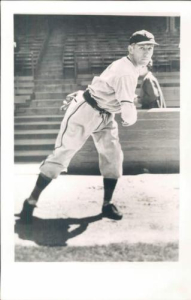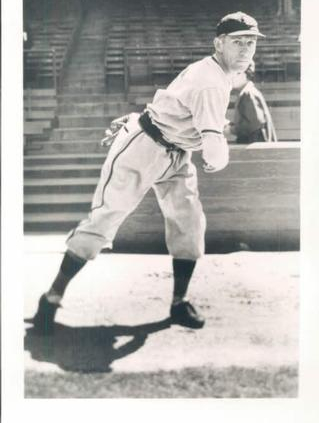August 30, 1938: Ed Cole wins only big-league game as Buster Mills, Red Kress star at plate
 It was another long season for the St. Louis Browns. The club brought in a new skipper in 1938, Gabby Street, who had guided the Cardinals to two pennants and a World Series title earlier in the decade, but “Old Sarge” could do little to alter the fortunes of a cash-strapped ballclub. En route to their ninth consecutive losing season and second-division finish, the Browns were 43-75 and owned the worst winning percentage (.364) in the American League when they arrived in Boston to play a three-game set against the Red Sox and conclude a 20-game road swing.
It was another long season for the St. Louis Browns. The club brought in a new skipper in 1938, Gabby Street, who had guided the Cardinals to two pennants and a World Series title earlier in the decade, but “Old Sarge” could do little to alter the fortunes of a cash-strapped ballclub. En route to their ninth consecutive losing season and second-division finish, the Browns were 43-75 and owned the worst winning percentage (.364) in the American League when they arrived in Boston to play a three-game set against the Red Sox and conclude a 20-game road swing.
The Browns were a robust-hitting team and would eventually finish third in the league in batting (.281), but were undone by their seemingly annual bugaboo: the worst pitching staff in the major leagues. The Browns hurlers had posted the big leagues’ highest team ERA the previous three seasons, including a whopping 6.24 in 1936, which “improved” to just 6.00 the following season. That dubious streak reached four in 1938 as another revolving cast of pitchers produced a 5.80 mark.
Unlike the Browns, the Red Sox were in the midst of a renaissance for player-manager Joe Cronin. Poised for their third consecutive winning season, a feat they had not accomplished since the halcyon days of Babe Ruth in the 1910s, the Red Sox (68-49) were in second place though trailing the New York Yankees by 14 games. Despite losing their last two games, they were playing some of their best ball of the season, and had won 13 of 18 entering the Browns series, the last games of a season-long 22-game homestand.
The starting pitchers were two reclamation projects. The Red Sox’ 37-year-old journeyman right-hander Joe Heving had been purchased from the Cleveland Indians at the beginning of the month. He had tossed complete-game victories in his last three starts to improve his career slate to 28-28 in parts of six big-league seasons dating back to 1930.
Toeing the rubber for the Browns was Ed Cole, a 29-year-old rookie who had been in Organized Baseball since 1931. Acquired along with Roy Hughes and Billy Sullivan in a trade with the Indians in February for disgruntled catcher Rollie Hemsley, Cole had had stints in spring training with both the Philadelphia Athletics and Phillies. He was coming off what proved to be the best season in his professional career, posting an 18-18 record with the Galveston Buccaneers in the Class-A1 Texas League, including a circuit-best 205 punchouts in 313 innings. Making just his fourth start, Cole had an 0-3 record and 5.10 ERA in 56⅔ innings over 26 appearances.
On a pleasant, 70-degree Tuesday afternoon in the Hub City,1 a matchup with the perennial also-ran Browns drew a paltry crowd of 2,800 paying customers to Fenway Park, less than a third of their season average of 8,610. A throng of more than 8,000 local student guests, however, gave the ballpark a more raucous atmosphere.2
The Browns came out swinging in the first inning. Three consecutive one-out singles resulted in the first run on Harlond Clift’s liner to plate George McQuinn. After Beau Bell was walked intentionally to fill the bags, Red Kress singled to left to drive in Buster Mills and Clift. Bell overran second and was thrown out there by left fielder Joe Vosmik. Billy Sullivan’s single advanced Kress to third, where he was stranded.
Cole had some bad luck in the second. With Ben Chapman on second via a single and sacrifice, first baseman McQuinn misplayed Johnny Peacock’s foul ball which should have been the third out. Given an extra strike, Peacock doubled to left to drive in Chapman and put the Red Sox on the board.
The Browns exploded for four runs in the fifth. It began with first baseman Jimmie Foxx flubbing Mel Almada’s grounder and McQuinn hitting a double. Both scored on former Red Sox player Buster Mills’ single. Clift, who eventually led the Browns with 34 home runs and 119 RBIs in 1938, doubled to send Heving to the showers. Rookie reliever Dick Midkiff was rudely greeted. He uncorked a wild pitch, allowing Mills to score. After Bell was retired, Kress singled to drive in Clift (the run charged to Heving), giving the Browns a 7-1 lead.
Cole breezed through a one-two-three fifth. He had pitched into the sixth just once previously, and was pounded for eight hits and nine runs (seven earned) in a loss to the New York Yankees on July 13. The potent Red Sox offense, which led the majors with a .299 batting average and trailed only the Yankees by averaging 6.0 runs per game in 1938, finally warmed up. Vosmik led off with a double but was doubled up on Foxx’s screeching liner to shortstop Kress. The next five batters reached base. Cronin doubled and scored on Pinky Higgins’ two-bagger. After Chapman walked, Bobby Doerr singled to plate Higgins. Peacock singled to fill the bases, but Cole induced Sullivan to pop up to second to avoid disaster.
A mini-brouhaha erupted to begin the seventh when Cronin signaled for Doc Cramer, the Red Sox’ starting center fielder, to take the mound. According to the Boston Globe, home-plate umpire Lou Kolls “feared that the Hose might be trying to burlesque the national pastime,” and requested a meeting with Cronin.3 The latter explained that “sheer necessity” and the ragged state of the team’s relief corps required him to call on Cramer.4 A star flychaser who regularly batted .300, Cramer had broken into to baseball in 1929 as a pitcher with the Martinsburg (West Virginia) Blue Sox in the Class-D Blue Ridge League but was moved to the outfield because of his hitting ability. He batted .404 and joined the Athletics as a September call-up that season. The Red Sox acquired him prior to the 1936 season. The Globe reported that Cramer “often tries out several trick deliveries” in batting practice and had pitched in exhibitions with the A’s, but was taking the mound for the first time in a major-league game.5
“I never realized,” said Cramer jokingly after the game, “just how close that home plate is to the pitcher’s box. How those hits whistle past your ears.”6 Mills greeted Cramer with a leadoff single and Clift walked. Both advanced on a daring double steal. Two batters later, Kress lined to left to drive in Mills while Clift reached third on Vosmik’s throwing error.
Cole’s struggles continued in the seventh. After Vosmik was thrown out trying to stretch a single into a double, Foxx walked and Cronin launched his 17th home run of the season into deep left to pull the Red Sox to within three, 8-5. Higgins walked, to send Cole to the showers. In relief came 44-year-old Fred Johnson, the majors’ oldest player. A feel-good story, Johnson joined the Browns in mid-July and had thrown in excess of 3,000 innings in the minors since his last appearances in the big leagues in 1923 with the New York Giants. He retired Chapman to end the frame.
With two on and two out in the eighth, Cramer yielded a double to Mills, his fourth hit of the game, to drive in the Browns’ ninth run. Second baseman Bobby Doerr’s relay throw from Chapman pegged McQuinn out at the plate to end the inning. Cramer was “liberally applauded” throughout his four-inning outing, reported the St. Louis Globe Democrat, “largely because home rooters hadn’t much else for which to cheer.”7
Johnson held the Red Sox to one hit (a ninth-inning double by Vosmik) over 2⅓ innings. He retired Cronin on a grounder to second to secure the Browns’ 9-5 victory in 2 hours and 17 minutes. The loss was the Red Sox’ season-high third in a row,
Mills (four hits, three runs, three RBIs) and Kress (two hits, four RBIs) proved to be the stars of the Browns’ victory, while Cramer’s novel pitching appearance garnered equally as much copy. Lost in the shuffle was Cole’s only big-league win. In 6⅔ innings, he surrendered 10 hits, five runs (all earned), walked five, and fanned two.
Epilogue: Cole finished the season with a 1-5 record and 5.18 ERA in 88⅔ innings. The following season he lost his only two decisions, was optioned to the minors in the offseason, and never made it back to the majors.
Acknowledgments
This article was fact-checked by Bruce Slutsky and copy-edited by Len Levin.
Sources
In addition to the sources cited in the Notes, the author accessed Retrosheet.org, Baseball-Reference.com, SABR.org, and the following newspaper article:
“Kress Drives Home Four Runs; B. Mills Bats Three Across,” St. Louis Post-Dispatch, August 30, 1938: 2A.
https://www.baseball-reference.com/boxes/BOS/BOS193808300.shtml
https://www.retrosheet.org/boxesetc/1938/B08300BOS1938.htm
Notes
1 “Weather Reports,” Boston Globe, August 31, 1938: 3.
2 Gerry Moore, “Cramer Pitches as Sox Go Down,” Boston Globe, August 31, 1938: 7.
3 Gerry Moore, “Cramer Pitches as Sox Go Down.”
4 Gerry Moore, “Relief Hurler Cramer Decides to Stick to Outfield,” Boston Globe, August 31, 1938: 10.
5 Gerry Moore, “Cramer Pitches as Sox Go Down.”
6 Gerry Moore, “Relief Hurler Cramer Decides to Stick to Outfield.”
7 Associated Press, “B. Mills, Kress Star as Browns Win,” St. Louis Globe-Democrat, August 31, 1938: 12.
Additional Stats
St. Louis Browns 9
Boston Red Sox 5
Fenway Park
Boston, MA
Box Score + PBP:
Corrections? Additions?
If you can help us improve this game story, contact us.


